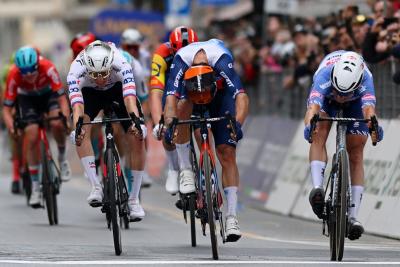Belgian sprinter Jasper Philipsen wins the fastest-ever edition of Milan-San Remo

MILAN — Saturday morning, the cycling world welcomed the first major classic race of the season: Milan-San Remo. “La Classicissimma” is quite photogenic a race: under an early Spring sun, the race, which is also called “La Primavera”, takes the peloton along the Ligurian coastline to charming San Remo.
With its 298 kilometres, Milan-San Remo also is the longest professional race. At the same time, however, it is one of the more predictable races as it usually is contended in a thrilling sprint on its final lane on Via Roma. It is rather the built-up which makes the race popular. Approaching the final two hills, the Cipressa and the Poggio, the peloton gradually steps up its speed and becomes ever more nervous. With its numerous turns and descents, Milan-San Remo is notorious for its crashes.
This year’s has been the race’s fastest edition ever: the average speed was an impressive 46.1 km/h. Prior to the race, there were two main contenders: the current world champion and last year winner, Dutch cyclist Mathieu Van der Poel, and Slovene cyclist Tadej Pogačar, arguably the world’s best cyclist and who the last couple of years finished 5th and 4th respectively. Whereas Pogačar has competed in only one race this season, Van Der Poel has not competed in any race at all. Contrary to traditional cycling logic, it seems that cyclists ever more prefer training camps to competitions.
Early Saturday morning, a group of nine riders set up a breakaway which would last 260 kilometres. It was not until the descent of the Cipressa, when two of them crashed, that the peloton finally caught the breakaway group.
On the following hill, the Poggio, Pogačar’s UAE Emirates team did what it had announced before the race it would do: keeping a high pace on the final hill and set a record time. “Climbing the Poggio in less than nine minutes,” was to be the success formula. Belgian UAE rider Tim Wellens lead the peloton and reduced it to a group of 30 riders. Yet, Pogačar did not manage to break away. Neither the Cipressa or the Poggio are sufficiently steep to really break away. Milan-San Remo is more about finding and maintaining one’s position in the peloton. Mathieu Van Der Poel could easily follow Pogačar and allowed the other riders to regroup. But when Pogačar attacked a second time, it was with great difficulty that Van Der Poel tried to join him. Fortunately for Van Der Poel they were near atop the hill. With only 5 km to go, and a descent on which Van Der Poel and Pogačar, both of them cyclo-crossers with excellent steering and equilibrium skills, could enlarge their small lead, all fans of cycling were set for an epic duel.
Yet, during the descent, Van der Poel did not collaborate with Pogačar. A third cyclo-crosser, British Tom Pidcock, managed to join the couple. Van der Poel knew that, this way, his team mate, Belgian top sprinter Jasper Philipsen, could still join the threesome and then, as the tradition of Milan-San Remo wants it, win the race in a sprint.
A kilometre before the finish line, Pidcock jumped, but he was caught soon. With less than 500 metres to go, it was clear that the top sprinters Philipsen and Australian Michael Matthews would dispute this edition of Milan-San Remo. Pogačar, also a fine sprinter, joined the sprint. Philipsen finished first, Matthews became a very close second and Pogačar finished third. Although the Poggio had been climbed in a record time, the bravura of the multi-millionaire UAE team lost from the shrewdness of the smaller Alpecin-Deceuninck team.
© COPYRIGHT ITALIAN INSIDER
UNAUTHORISED REPRODUCTION FORBIDDEN


